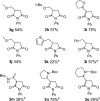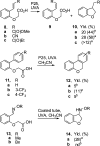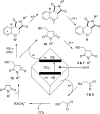Titania-promoted carboxylic acid alkylations of alkenes and cascade addition-cyclizations
- PMID: 24437519
- PMCID: PMC3963454
- DOI: 10.1021/jo4027929
Titania-promoted carboxylic acid alkylations of alkenes and cascade addition-cyclizations
Abstract
Photochemical reactions employing TiO2 and carboxylic acids under dry anaerobic conditions led to several types of C-C bond-forming processes with electron-deficient alkenes. The efficiency of alkylation varied appreciably with substituents in the carboxylic acids. The reactions of aryloxyacetic acids with maleimides resulted in a cascade process in which a pyrrolochromene derivative accompanied the alkylated succinimide. The selectivity for one or other of these products could be tuned to some extent by employing the photoredox catalyst under different conditions. Aryloxyacetic acids adapted for intramolecular ring closures by inclusion of 2-alkenyl, 2-aryl, or 2-oximinyl functionality reacted rather poorly. Profiles of reactant consumption and product formation for these systems were obtained by an in situ NMR monitoring technique. An array of different catalyst forms were tested for efficiency and ease of use. The proposed mechanism, involving hole capture at the TiO2 surface by the carboxylates followed by CO2 loss, was supported by EPR spectroscopic evidence of the intermediates. Deuterium labeling indicated that the titania likely donates protons from surface hydroxyl groups as well as supplying electrons and holes, thus acting as both a catalyst and a reaction partner.
Figures








Similar articles
-
In situ EPR studies of reaction pathways in Titania photocatalyst-promoted alkylation of alkenes.Molecules. 2015 Mar 3;20(3):4055-70. doi: 10.3390/molecules20034055. Molecules. 2015. PMID: 25741899 Free PMC article.
-
Unconventional titania photocatalysis: direct deployment of carboxylic acids in alkylations and annulations.J Am Chem Soc. 2012 Aug 22;134(33):13580-3. doi: 10.1021/ja306168h. Epub 2012 Aug 10. J Am Chem Soc. 2012. PMID: 22867432
-
Preparative semiconductor photoredox catalysis: An emerging theme in organic synthesis.Beilstein J Org Chem. 2015 Sep 9;11:1570-82. doi: 10.3762/bjoc.11.173. eCollection 2015. Beilstein J Org Chem. 2015. PMID: 26664577 Free PMC article. Review.
-
Advances in Rhodium-Catalyzed Oxidative Arene Alkenylation.Acc Chem Res. 2020 Apr 21;53(4):920-936. doi: 10.1021/acs.accounts.0c00036. Epub 2020 Apr 2. Acc Chem Res. 2020. PMID: 32239913
-
Development of cascade reactions for the concise construction of diverse heterocyclic architectures.Acc Chem Res. 2012 Aug 21;45(8):1278-93. doi: 10.1021/ar200338s. Epub 2012 May 11. Acc Chem Res. 2012. PMID: 22577988 Review.
Cited by
-
Direct decarboxylative Giese amidations: photocatalytic vs. metal- and light-free.Chem Sci. 2023 Aug 24;14(36):9806-9813. doi: 10.1039/d3sc03143h. eCollection 2023 Sep 20. Chem Sci. 2023. PMID: 37736650 Free PMC article.
-
Hydrogenations without hydrogen: titania photocatalyzed reductions of maleimides and aldehydes.Molecules. 2014 Sep 24;19(9):15324-38. doi: 10.3390/molecules190915324. Molecules. 2014. PMID: 25255248 Free PMC article.
-
TiO₂ Photocatalysis for Transfer Hydrogenation.Molecules. 2019 Jan 17;24(2):330. doi: 10.3390/molecules24020330. Molecules. 2019. PMID: 30658472 Free PMC article. Review.
-
In situ EPR studies of reaction pathways in Titania photocatalyst-promoted alkylation of alkenes.Molecules. 2015 Mar 3;20(3):4055-70. doi: 10.3390/molecules20034055. Molecules. 2015. PMID: 25741899 Free PMC article.
-
Heterogeneous Photocatalysis as a Potent Tool for Organic Synthesis: Cross-Dehydrogenative C-C Coupling of N-Heterocycles with Ethers Employing TiO2/N-Hydroxyphthalimide System under Visible Light.Molecules. 2023 Jan 17;28(3):934. doi: 10.3390/molecules28030934. Molecules. 2023. PMID: 36770603 Free PMC article.
References
-
- For a review, see:Calvert J. G.; Pitts J. N.. Photochemistry; Wiley: New York, 1966; pp 427–434.
-
- Budac D.; Wan P. J. Photochem. Photobiol., A 1992, 67, 135–166.
-
- For a review, see:Nonhebel D. C.; Walton J. C. In Free Radical Chemistry; Cambridge University Press: Cambridge, U.K., 1974; pp 99–127.
-
- Barton D. H. R.; Crich D.; Motherwell W. B. J. Chem. Soc., Chem. Commun. 1983, 939–941.
- Motherwell W. B.; Crich D.. Free Radical Chain Reactions in Organic Synthesis; Academic Press: London, 1992.
-
- Johnson R. G.; Ingham R. K. Chem. Rev. 1956, 56, 219–269.
- Baker F. W.; Holtz H. D.; Stock L. M. J. Org. Chem. 1963, 28, 514–516.
LinkOut - more resources
Full Text Sources
Other Literature Sources

